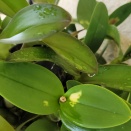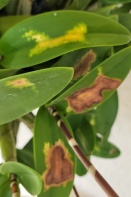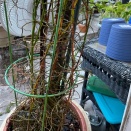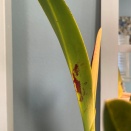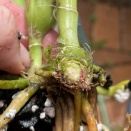Orchid Culture - 2022 Questions & Answers
If you like what you see, feel free to leave a donation; just click on the Tip Jar. Thank you!by Sue Bottom, from the St. Augustine Orchid Society Newsletter. Email us with any orchid question, if we can't answer it we'll find someone who can! Send photographs too!
Phalaenopsis Leaves Yellowing
Q. The leaves on this phalaenopsis orchid are turning yellow. Is that normal? I water it once a week. Thanks for any advice you can give.A. It's not abnormal to lose a bottom leaf on a phal, even two, if it happens slowly and they just drop off. But, this looks like it's happening quickly and you're losing the bottom two leaves plus another pretty quickly, so that suggests there's a problem. The leaves are also yellowing from the stem outward, suggesting a problem with the central crown. You better knock it out of the pot and check the roots. You may find the crown is disintegrating, in which case the plant is probably a goner, or you may find the roots are in rough shape, in which case you may be able to rehab it. Send a pic of the plant once you've knocked it out of the pot. Barbara sent pics, the roots looked good but the crown was rotting, probably collar rot, also known as Southern Blight, so the last rites were administered. (Dec-22)
Post Hurricane Infection
Q. What is causing these leaf lesions that are sunken on front and discolorations on back that have occurred since Hurricane Ian? It was on the north side of house under eaves during our 7" blowing rains.A. If that is the newest growth, the leaf probably was soft and tender, a treat for whatever bacteria invaded it after the storm. You can remove the leaf, but it does still have good sections. As long as the bacterial infection isn't active, you can leave the leaf on the plant. You might spray it with some peroxide or better yet some copper to keep the infection under control. (Dec-22)
Catasetum Backbulb Rotting
Q. I’m doing winter prep and a couple of my catasetum have yellow sort of mushy shoots. Should I just cut them off? I’m afraid of leaving them until spring for fear the others will get infected.A. I cut away any rotten back bulbs. It is some sort of rot. (Dec-22)
Watering Oncidium
Q. The pseudobulbs on this Oncidium Sharry Baby plumped up so big and her leaves did the wrinkle thing. I am afraid of over-watering her. She’s in media that allows water to freely run through; in fact I try to put her in a bucket at least once a week for one of the waterings and I’m trying to use up my Palmers fertilizer that turned black and mushy on me (ugh!).A. That Sharry Baby looks totally happy. Pseudobulbs plumping up big, check, good job. I don't see any accordion wrinkling in the leaves, but you may be seeing in person what I can't see in the pics. If she's in a freely draining mix, watering two or three times a week should be fine. If that requires more time than you have, you might consider adding a little chopped sphagnum (only the good stuff!) into your mix next time you repot so it will retain a little more water. Also, you could use a plastic rather than a clay pot to help retain moisture, you can still drop the plastic pot into a clay pot for stability. I don't think I'd change a thing that you are doing right now. And don't worry about the mucky fertilizer, if you're using a Cal Mag type fertilizer it is hygroscopic so it absorbs moisture from the air. If you just have a small bag, you can store it in the fridge going forward and that will help keep it dry. Enjoy the blooms, looks like they're gonna be fantastic! (Nov-22)
Flower Damage
Q. One of our Barbados Orchid Society members is experiencing problems with his dendrobiums. These photos showing the damage done especially to the buds. He believes it might be hibiscus gall midge but would appreciate your input.A. I haven't had blossom midges (that I knew about), but from what I understand, blossom midges are tiny flies, about the size of a gnat, where the larvae feed inside unopened flowers. The eggs are deposited into the open tips of flower buds. They are white to cream colored, invisible to the naked eye, and hatch within 24 hours into maggots that move into the bud and feed on fluids from the damaged plant tissue. The maggots mature in 5–7 days, growing to 1⁄12 inch long (about the thickness of a nickel). The maggots can exit the buds and burrow into the soil to pupate, like fruit flies. Most of the control methods I've read involve removing any damaged flowers, double bagging and discarding them to remove the larvae. I'd probably also do a sloppy drench of Bacillus thuringiensis (Bt), applying it to any buds and letting it seep into the soil/potting mix below the flowers to try to interrupt the life cycle. (Nov-22)
Chlorotic Markings on Dendrobium Leaf
Q. I have this yellow discoloration on several Dendrobiums. They both are negative for virus, and neither has bugs at this time, but they have had random mite issues in the past. Of course, both of these orchids get high natural light in my sunroom. Is this sun damage, a fungal or bacterial issue, or a deficiency of some kind?A. The first leaf image looked like a possible infection with one of the cercosporoid fungi, but Laurie said there is a ceiling fan in the sunroom and she hand waters her orchids in the sink so rarely has fungal issues. She asked about possible orchid fleck virus (OFV) and sent over images of some more severely impacted leaves. These pictures match some of the images of orchid fleck virus shown in technical papers and the Hark Orchideen website. Symptoms vary but leaves can exhibit chlorotic or necrotic flecks, spots or ring spots, as well as chlorotic mosaics and mottles, and it is spread by a type of flat mite. There is no test strip for OFV and we are not aware of a commercial laboratory that tests for OFV, so we can't confirm the diagnosis. (Nov-22)
Cattleya Growing at Weird Angle
Q. This growth is the strangest I've seen. The new growth is growing straight out at an angle and there are aerial roots. I thought I'd risk cutting this new growth off that has its roots airborne, although there are bud sheaths.A. As long as you have three or four pseudobulbs, I would cut away the new growth just above where it is rising out of the pot. That piece that is horizontal will ultimately turn upward toward the light, particularly if you gently encourage it to do so with some twist ties. You might consider putting that rambling growth in a basket. Leave the rest of the plant in the pot and hopefully you'll get back bulbs to sprout. (Oct-22)
Black Leaf Tips on Epicatt
Q. I have an enormous Epicatt that has always grown and bloomed fine but I recently noticed black leaf tips. Any ideas?A. At first glance, I thought this was an issue with water pooling in the new growth and causing a rot, but the black discoloration begins on the leaf tip and moves down the leaf. This looks more like a calcium deficiency in the new growth. Perhaps consider using calcium supplements, particularly during the rainy season. The Miracle Gro Shake 'N Feed for tomatoes, fruit trees and vegetables is a time release fertilizer containing calcium, for those that don't have a regular fertilizing schedule. (Oct-22)
Flower Problem
Q. Almost all flowers on this Cat opened with a strange problem. It mostly affected the lip but some petals as well, even though the buds looked fine and the outer petals were not always affected.A. That looks like bacterial blighting on the flowers, probably caused by all the rain we have been having. Either water condensed in the bud or soaked into the bud before it opened, and an opportunistic bacteria started the infection. The flowers are ruined, but you can remove them easily and eliminate the problem from your growing area. If you can move your budding plants to a covered area when we're having these extensive rain events, you'll be able to protect the blooms. (Oct-22)
Blackening New Growth
Q. What’s causing this blackening from the new growth tip down?A. My guess was that you must have had water pooling in there as the growth was forming and caused the localize rot. It is a problem this time of year when the high humidity doesn't allow leaves to dry out quickly. If you see areas where water can pocket around your soft new growths, gently pull the sheath down to allow any condensation or accumulation of water to drain freely. (Sep-22)
Possible Virus
Q. This Cattleya Sea Breeze was gifted to me in April. I have kept it outside since then. It has had 6 blooms, all look like the one pictured. The plant looks okay, way over pot bound, had lots of leads this year, but the flowers look funky. What is going on?A. After looking at the first picture, I thought there was thrips damage. Those clearish areas with a bulls eye in the center are most likely caused by thrips. There were also some areas in the petals where there was darker pigmentation that was a concern, maybe viral color break or caused by thrips. I asked for more pictures and the verdict was in. Definitely thrips damage and most likely virused too. The dark asymmetric streaks that aren't associated with the thrips damage and the black speckling on the older leaf are both suggestive of virus. This plant was tossed to avoid problems with his other healthy orchids. (Sep-22)
Sunburn Damage
Q. This Vanda had a great spike that was coming out and it turned black on me. I have it hanging from a hibiscus on the side of the house. It does not get direct sunlight. I don’t think it is because of the sun.A. I think the leaves got sunburned. Either there is more light there during certain times of the day than you are aware, or it was not acclimated to that level of light. The bloom spike could be sunburn, particularly if the blackening happened in one day like the sunburn. Otherwise, thrips are a possibility. (Sep-22)
Does This Phal Have to be Repotted
Q. I have a very healthy phal that is in a plastic skin. I've had it for 6 months and water it weekly. Should I take it out of the skin and transplant into media, or leave it alone?A. If the sphagnum moss is still in good condition and you are comfortable watering it, you can leave it as it is for another year. Some people say they hate sphagnum moss because it causes root rot, though it may be that they water the plant in sphagnum too often and that is what causes the problem. That sphagnum is packed from top to bottom in the pot and it holds a lot of water. The commercial growers water more like once every 3 weeks rather than weekly. It may feel dry to the touch at the top of the pot, but in the bottom it stays wetter than your think for longer. For now, you could leave it in the existing pot or remove the plastic and drop it into a clay pot, find a protected place outdoors under cover and a little shady to let it summer, and then bring it back in after the first cold snap. That chill down into the low 60s for 2 or 3 weeks will trigger the flowering process. Then bring it indoors for the winter, and repot in June after it blooms. (Aug-22)
Thrips on Damaged Bud
Q. I looked inside a damaged bud and out crawled several of these thrips pupa. They were barely visible, about the size of an apostrophe on a smart phone, normal sized font.A. Thrips can ruin your flowers quickly. Learn to recognize the signs of thrips damage. I do bimonthly Orthene drenches as a precaution against thrips in the greenhouse, and it has worked as long as I stick to the schedule. (Aug-22)
Viral Leaf Symptoms
Q. "Eagle Eye" Dave Off from Waldor Orchids wrote: "This is B. nodosa 'Godzilla' AM/AOS. The black spots made me test for virus, it tested positive for ORSV. Those black marks are a symptom. Good bye $200 plant."A. The reddish brown discoloration at the nodes looks suspicious, I have not seen markings like that before. The black marks on the leaf I would have thought were a bacterial problem. Your 6th sense must have kicked in to make you test it for virus, what a bummer. (Aug-22)
Water Pocketing Causes Rot
Q. We discovered this on Bc. Norman’s Bay ‘Low‘. We had watered three days ago and had not seen this. We are going to remove affected areas, treat cuts with hydrogen peroxide and then with Daconil. Since this has moved so rapidly, I feel I have to do something.A. I don't think that is fungal, I think it is bacterial, particularly with how fast it moved. My guess is on the front lead that is really rotted, water pooled in the cataphyll and caused the rot. Perhaps on the other lead, water just sat on the horizontal section of the leaf and caused the localized rot. For the first one, you'll have to cut away all the rotten tissue and treat with a freshly opened bottle of hydrogen peroxide. For the second, you can just pour peroxide on it but you don't have to cut away the tissue, as long as the discolored area doesn't expand and water isn't pooling, you should be fine. I watch the sheaths on new growths to make sure water can't accumulate. You can gently pull down the cataphyll to eliminate the pocket that traps water. The plant looks nice and healthy and will recover easily from this setback. (Jul-22)
White Spots Turn Yellow Then Brown
Q. I bought it this Schomburgkia at Tamiami from an international vendor and it started having problems several days after I got home. The leaves appear to be turning white (always in the middle never on the edges), then yellow, and finally brown with sunken spots on both sides of the leaves. It is otherwise very healthy with twelve new growths and 17 flower spikes. I would hate to lose this plant!A. I think it is either heat damage from the trip home or cold damage from the trip in the jet to get here. The markings are very similar to sunburn, but the burn does not appear on the highest point of the leaf getting the most direct sun, so that would suggest not sunburn, although the plant orientation in the car on the way home might have changed the normal sun angle. More likely it is heat damage during the 3 hour trip home, perhaps it was stuck in a part of the car that wasn't get much of the A/C. The foreign vendor suggests another possibility, and that is the damage occurred in transit at 35,000 ft where the air is pretty cold. At any rate, the good news is that there's really not much you can do now except for wait for it to outgrow the damage. The plant looks incredibly healthy; this is just a hiccup. You can remove the severely damaged leaves if you don't want to look at them. (Jul-22)
Terete Vanda Base Yellowing
Q. My 10-foot tall Papilionanthe Miss Joaquim has bloomed every summer for me but bringing her into the garage this past winter and/or thrips seems to have caused large yellow breaks in a couple of the canes. I’m thinking I need to cut that out and root what’s above the yellow that’s green and appears viable. Is that a reasonable plan?A. I don't think that's thrips or cold damage, I think the older part of the plant just tires out and starts to die back, and the future of the plant is in the top pieces. I end up cutting up my terete vandas every year, discarding the bottom pieces and re-situating them in the pot and tying them off to the basket. They don't seem to miss a beat. I think your plan is totally reasonable. (Jul-22)
Broad Mite Damage Hard to Diagnose
Q. The Pholidota grew, but didn't bloom. Each year I went through this process of nice new growth and then leaf spotting that looked like it was fungal in origin, perhaps Cercosporoid? When I looked at the underside of the leaf, I noticed a focal point that was considerably darker. With a stereoscope and about 60X magnification, there was an obvious wound or crater with dead tissue, and some odd white particles. Then I noticed the little leg projections on a white carcass at another wound site. So I started looking around the leaf in general and suddenly saw something moving, a mite! There's no way the naked eye could see this. This is at least 60X magnification. But at least I now know to use a miticide.A. It is very hard to diagnose damage from these microscopic mites because you can't see them, so you tend to assume the damage is fungal in origin even though no spores are evident. From the very useful website Hark Orchideen: Tarsonemids (Tarsonemidae) are very small, about 0.2-0.3 mm long, elliptic, transparent mites that live hidden directly at the vegetation point of orchids, i.e. in the heart of the plants. Their fourth pair of legs is always different from the third one, in Tarsonemus pallidus Banks it is markedly stronger. The mites multiply in high temperatures and high relative humidity. Development from egg to adult takes about 14 days in temperatures between 20 and 25° C. The mites are sensitive to light and prefer young soft plant tissue... Reduce humidity, if possible. Spraying with acaricides has to be carried out repeatedly." (Jun-22)
Black Markings on Vanda
Q. I have black smudges on my vanda from the top to the bottom leaves, that just appeared on an orchid I purchased in the last month. I've been told it is Thai crud. What can I do?A. Thai crud will produce diamond shaped lesions on the leaf that have a sandpapery feel. That's not Thai crud on your vanda, that is mold. You can take a hose end sprayer and wash it off the plant, and then spray it with some Consan or Pool algaecide (20% pool algaecide contains similar substances as Consan) and they are low toxicity products. Your plant is going to be fine. I would say you have too much leaf wetness causing the mold, or you don't have enough air movement drying the plant after it is wet. It is a much easier problem to solve than Thai crud, you just have to find the right place for it. (Jun-22)
Fungal Rot
Q. This poor plant is having a problem. Can you suggest a treatment?A. That is a fungal rot that is moving through the rhizome and up into the pseudobulbs. All the diseased tissue has to be cut away and then the healthy part put into a fresh potting mix. Be sure to torch your shears between cuts. Drench with a good systemic fungicide like Heritage or Pageant afterwards. We'll be at the repotting clinic at the SE Branch library the first Saturday of the month if you need some help. (May-22)
Phal Not Doing Well
Q. My orchid is not doing well, what should I do?A. It looks like it is losing its lower leaves and the flowers have faded. They usually bloom for around 3 months, but of course you don't know when it started flowering so it could just be the end of their normal life or it could be related to the leaf loss issue. It also looks like that sphagnum moss is getting older which means it is starting to break down and then it can compress and start smothering the roots. I would say it's probably ready to be repotted. Hopefully there's no root rot going on, but that would be the fear, causing it to lose leaves and flowers. Knock it out of the pot and take a look at the roots, and be prepared to put it in fresh mix. (May-22)
Dendrochilum Potting
Q. I was lucky to have won Dendrochilum cobbianum from the raffle table. I think I have the wrong potting material?A. I grow my dendrochilums in a shallow layer (about an inch or two) of long fibered New Zealand sphagnum moss placed over styrofoam. It looks like you have some moss in there and some river rocks, can't tell how deep the pot is. They like to be kept moist. It looks like the back bulbs on your plant are soft, if they are, you should consider removing them. It also looks like a pretty large pot for the size of the plant/root mass. A smaller bulb pan would work very well. Otherwise, use a smaller, shallow pot with lots of styrofoam in the bottom. (May-22)
Paph Flower Rotting
Q. I suspect a crown rot and not a bud. What would you advise? They have now been put closer to the fan so the centers dry out quicker. They were on the ground underneath my orchids and I think it stayed too damp.A. That is the emerging flower bud. If the bud is rotting, I would suspect dew/condensation settled in the fan and rotted the bulb. If that's the case, you can remove it and pour some fresh hydrogen peroxide into the fan, draining away the water after 15 minutes or so. If the bud is not rotting, rejoice, cause that is a beautiful multi-floral paph! (Apr-22)
Sponge Vase
Q. Can vase sponges be used as an orchid pot? Do they require desalination prior to use?A. Did you get those sponges from Tarpon Springs? They are harvested from salt water, and then processed which involves a lot of rinsing. I just tested one of mine by running some water through it and it wasn't particularly salty. I'd soak it good before using it, changing the water a few times. I wonder how long it will last without breaking down, let me know! (Apr-22)
Over-potted Dendrobium
Q. I purchased this antelope type dendrobium that was originally mounted upside down on a board. Is this a dendrobium that goes dormant? I can’t seem to make it happy.A. The spatulata type dendrobiums grow pretty much like cattleyas. If you took it off its mount and put it in a pot, you probably compromised the root system which basically doesn't like to be disturbed. They grow well in pots, usually pots much smaller than you think they need because the canes grow so closely together. A good dendrobium potting mix is one with not too much organic material because organic material breaks down after a couple years, and then it must be replaced with fresh material, so you disturb those roots again. Keep it a little drier during the winter season until new roots are ready to grow in the spring, and then think about putting it into a smaller pot with a coarse potting mix. (Apr-22)
Over-potted Dendrobium
Q. I am in a panic mode. I lost my Vanda tessellata 3 weeks ago to what appeared to have been a sudden bacterial infection that spread like fire in a few days. This morning my very healthy Gongora atropurpurea is covered with what appears to be bacterial infection. I discovered the problem on 4 more stanhopeas, all in the immediate vicinity of the Gongora. All 5 plants are very good plants and I am disheartened but hopeful that trimming and spraying will allow them to come back. I also keep them dry for now and isolated.A. I don't think that is rot from the cold weather per se, I'd guess the damage was caused by cold water dripping onto the leaves and causing the localized cell collapse followed by a bacterial infection. With this cold weather, water can readily condense and drip on the leaves. Wet plus cold is a deadly combination. I think your instincts are correct, trimming away the bacterial infection will help stop it from spreading and copper sprays should be protective of the remaining leaves. I'm guessing your well established plants will throw off a bumper crop of new unblemished leaves soon. (Mar-22)
Reddish Leaf Markings on Cattleya
Q. My first concern is the wine colored marks that have appeared on the newest growth of my Cattleya (Laelia) purpurata. Should I be concerned?A. My first thought when I saw that wine colored discoloration on the new leaf was the possibility that it was a sign of virus, in particular Odontoglossum Ringspot Virus. I asked for a picture of the flower, because ORSV often is reflected in color break in the flower. The flower could just be exhibiting a suffusion of color in the petals, or it could be color break because the markings are more distinct on one petal than the other, and color break is assymetrical. Jan ordered some test strips, and alas, it tested positive for ORSV. (Mar-22)
Red Rhizome Ring
Q. On repotting an epidendrum recently, I noticed this half circle of red on the rhizome. Is this red ring always fusarium fungus, even in an otherwise healthy plant? If I can’t prune it away and it appears to be through out the whole rhizome, do I need to throw the plant out? Can it be treated?A. It sure looks like fusarium, but perhaps it hasn't totally invaded the vascular system in that the entire rhizome doesn't look affected. I would sterilize between cuts, and keep cutting until you don't see the red ring. The pseudobulbs don't look compromised/dehydrated like they would from a fusarium wilt. I don't know if you can cure fusarium as opposed to prevent it from spreading/infecting new tissue, but a highly rated chemical would be one containing the active ingredient pyraclostrobin like Pageant or Empress Intrinsic. (Mar-22)
Catasetum Growth Beginning
Q. Is it time to start re-watering when I see signs of growth?A. No, it's time to repot, if it needs repotting. Whether you repot it or not, do not water until the plant is about 5 inches tall and the leaves have unfurled. Otherwise you will likely get crown rot in the tender new growth. (Feb-22)
Leafless Catasetum
Q. I have 4 small catasetums all of which have basically no leaves but a few spikes. Should I be watering them or leave them dry to be dormant? It’s been so warm, don’t know if they’re confused or this is normal.A. I'm guessing that catasetinae is really a Mormodia, which is a hybrid between a Mormodes and a Clowesia. The small flowered Clowesia are winter bloomers from leafless bulbs, very floriferous. You don't need to water them unless you feel like the bulbs are shriveling up. If you feel compelled to give it some water, you can place it in a saucer and let it wick up moisture from the bottom. (Feb-22)
Yellow Pseudobulb on Nobile Den
Q. I bought some Dendrobium Nobile orchids a few weeks back and one of them now has a yellow and soft pseudobulb. I water them once a week so I'm not sure if I over watered them or not. Should I remove the pseudobulb or let it remain there?A. I'm sure you have read about the nobile dendrobiums and how they like a coolish, dryish winter rest. The nobile pseudobulbs are much softer than those on other dendrobiums, but they should not be yellow. That means they are beginning to rot. If it starts to blacken or get mushy, cut it off. You probably shouldn't be watering it once a week, particularly with it being in sphagnum moss. You should let the moss dry entirely before watering until after growth begins in the spring. (Feb-22)
Oxalis in Orchid Pots
Q. I decided to try the Bonide Chickweed, Clover and Oxalis weed killer. It did a pretty good job. The sprayer it comes with is not that great and it seems like you need to get good coverage on the leaves for it to be effective. So I tried a fine mist sprayer from RePotMe.com and it worked much better Thus far, I have not seen any negative effects on the orchids.A. That's great information. I had to buy from EBay because the local stores didn't carry it and Amazon wouldn't ship to my location. I'll try that on the oxalis growing around my stanhopeas, they have resisted everything I've sprayed on them. April update: I tried some on some stanhopeas that had a persistent case of oxalis, and ended up losing some leaves so I can't recommend it on the thin leaved orchids. I'll continue using products with the active ingredient Diuron, it just may require more than one application. (Jan-22)
Dendrobium Needs Repotting
Q. This dendrobium has really grown. It has been in this pot for the past three years and is growing out of the pot. How should I repot it and how much bigger the pot should be?A. You may consider just dropping it into a larger pot. If it is currently potted in bark, you might want to jet out all the bark you can by turning the plant and pot upside down and spraying the media with a hand nozzle set to jet. Then just drop it into a larger pot and let the roots grow into and around the new pot. (Jan-22)
Phalaenopsis Leaf Blemish
Q. I'm having an issue and can't seem to identify problem. It seems to be moving throughout the plant.A. I think that is one of the Cercosporoid fungi. You can see a pentagonal blotching in the leaf discoloration. It is really pervasive in dendrobiums. You'll have to remove the damaged leaves to remove the source of inoculum from your growing area. I suspect the cooler nights we've been having caused condensation on the leaves which helps the fungus develop. More air movement, less leaf wetness and spraying during danger periods helps. Daconil and Pageant are highly rated for it, you can use Thiomyl or Banrot in a pinch. (Jan-22)



























